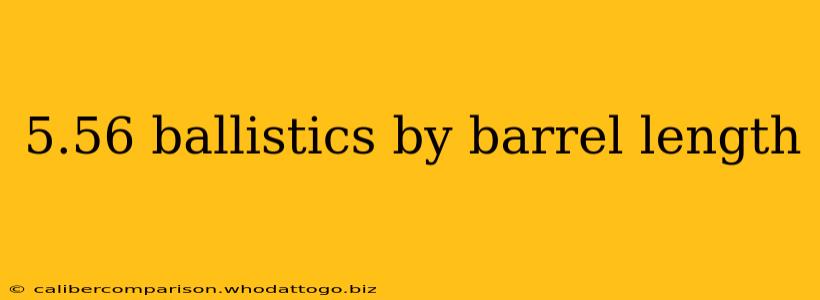Understanding how barrel length impacts 5.56x45mm NATO (.223 Remington) ballistics is crucial for both firearm enthusiasts and professionals. This guide delves into the complex relationship between barrel length and various ballistic characteristics, providing a detailed analysis that goes beyond simple bullet speed comparisons. We'll explore the factors influencing velocity, accuracy, and overall performance, empowering you to make informed decisions based on your specific needs.
The Impact of Barrel Length on Muzzle Velocity
The most readily apparent effect of barrel length on 5.56 ballistics is muzzle velocity. A longer barrel allows for more complete propellant burn, resulting in higher velocity. This increased velocity translates to a flatter trajectory, longer range, and increased downrange energy. However, the relationship isn't linear. The gains in velocity diminish as barrel length increases, eventually reaching a point of diminishing returns.
-
Shorter Barrels (Under 14.5 inches): These barrels sacrifice velocity significantly. While offering increased maneuverability and weight reduction, they produce lower muzzle energy and a more pronounced bullet drop. Subsonic rounds may become more common with shorter barrels.
-
Medium-Length Barrels (14.5 - 18 inches): This range provides a balance between velocity and maneuverability. They offer a good compromise between performance and practicality, making them popular choices for many applications.
-
Longer Barrels (Over 18 inches): These barrels extract the maximum velocity from the cartridge, resulting in a flatter trajectory and extended effective range. However, they add significant weight and length, impacting handling and maneuverability.
Factors Affecting Velocity Beyond Barrel Length
While barrel length is paramount, other factors influence muzzle velocity:
-
Propellant type and quantity: Different propellants burn at varying rates, impacting velocity. The amount of propellant loaded also plays a significant role.
-
Bullet weight: Heavier bullets generally achieve lower velocities than lighter bullets with the same propellant charge.
-
Barrel twist rate: The rate of rifling in the barrel affects stabilization and velocity, though the effect is less pronounced than barrel length.
-
Environmental conditions: Temperature, humidity, and altitude can all affect propellant burn rate and therefore muzzle velocity.
Accuracy and Barrel Length: A Complex Relationship
While higher velocity generally equates to better long-range accuracy due to flatter trajectory, the relationship between barrel length and accuracy isn't straightforward. Shorter barrels can sometimes exhibit increased accuracy at shorter ranges due to reduced barrel harmonics and vibrations. However, longer barrels generally offer superior long-range accuracy, especially when using heavier bullets.
The optimal barrel length for accuracy depends on many factors, including the ammunition used, the shooter's skill, and the intended application. Experimentation and testing are crucial to determine the best barrel length for your specific needs.
Gas System Considerations and Barrel Length
The gas system in an AR-15 style platform interacts significantly with barrel length. Gas systems are designed to optimally cycle the action, and improper gas system length for a given barrel length can lead to malfunctions. Carbine-length gas systems are often paired with shorter barrels, while mid-length and rifle-length gas systems are typically found in longer barreled rifles. This careful balancing act is essential for reliable functioning.
Conclusion: Choosing the Right Barrel Length
Selecting the optimal barrel length for your 5.56 firearm is a critical decision that depends heavily on your intended use. For close-quarters combat or home defense, shorter barrels offer maneuverability. Longer barrels provide superior velocity and accuracy at extended ranges. Careful consideration of the trade-offs between velocity, accuracy, maneuverability, and reliability will guide you toward the perfect barrel length for your individual requirements. Remember that practical testing and experimentation are invaluable in achieving optimal performance.

